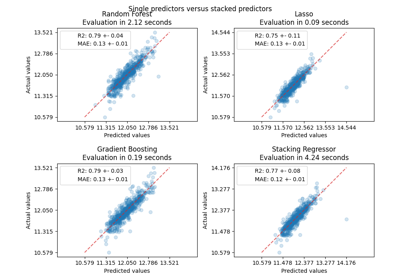Note
Go to the end to download the full example code. or to run this example in your browser via Binder
显示估计器和复杂的管道#
这个例子展示了显示估计器和管道的不同方法。
from sklearn.compose import make_column_transformer
from sklearn.impute import SimpleImputer
from sklearn.linear_model import LogisticRegression
from sklearn.pipeline import make_pipeline
from sklearn.preprocessing import OneHotEncoder, StandardScaler
紧凑文本表示#
估计器在作为字符串显示时,只会显示已设置为非默认值的参数。这减少了视觉噪音,并使比较实例时更容易发现差异。
lr = LogisticRegression(penalty="l1")
print(lr)
LogisticRegression(penalty='l1')
丰富的HTML表示#
在笔记本中,估计器和管道将使用丰富的HTML表示。这对于总结管道和其他复合估计器的结构特别有用,并具有交互性以提供详细信息。点击下面的示例图像以展开管道元素。有关如何使用此功能,请参见 复合估计器的可视化 。
num_proc = make_pipeline(SimpleImputer(strategy="median"), StandardScaler())
cat_proc = make_pipeline(
SimpleImputer(strategy="constant", fill_value="missing"),
OneHotEncoder(handle_unknown="ignore"),
)
preprocessor = make_column_transformer(
(num_proc, ("feat1", "feat3")), (cat_proc, ("feat0", "feat2"))
)
clf = make_pipeline(preprocessor, LogisticRegression())
clf
Total running time of the script: (0 minutes 0.012 seconds)
Related examples





